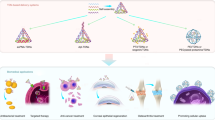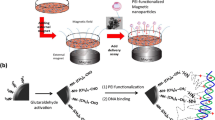Abstract
Semiconductor quantum dots (QDs) are considered as ideal fluorescent probes owing to their intrinsic optical properties. It has been demonstrated that the size and shape of nanoparticles significantly influence their behaviors in biological systems. In particular, one-dimensional (1D) nanoparticles with larger aspect ratios are desirable for cellular uptake. Here, we explore a facile and green method to prepare novel 1D wormlike QDs@SiO2 nanoparticles with controlled aspect ratios, wherein multiple QDs are arranged in the centerline of the nanoparticles. Then, an excellent cationic gene carrier, ethanolamine-functionalized poly(glycidyl methacrylate) (denoted by BUCT-PGEA), was in-situ produced via atom transfer radical polymerization on the surface of the QDs@SiO2 nanoparticles to achieve stable surfaces (QDs@SiO2-PGEA) for effective bioapplications. We found that the wormlike QDs@SiO2-PGEA nanoparticles demonstrated much higher gene transfection performance than ordinary spherical counterparts. In addition, the wormlike nanoparticles with larger aspect ratio performed better than those with smaller ratio. Furthermore, the gene delivery processes including cell entry and plasmid DNA (pDNA) escape and transport were also tracked in real time by the QDs@SiO2-PGEA/pDNA complexes. This work realized the integration of efficient gene delivery and real-time imaging within one controlled 1D nanostructure. These constructs will likely provide useful information regarding the interaction of nanoparticles with biological systems.

Similar content being viewed by others

References
Lim, E. K.; Kim, T.; Paik, S.; Haam, S.; Huh, Y. M.; Lee, K. Nanomaterials for theranostics: Recent advances and future challenges. Chem. Rev. 2015, 115, 327–394.
Louie, A. Multimodality imaging probes: Design and challenges. Chem. Rev. 2010, 110, 3146–3195.
Mattoussi, H.; Palui, G.; Na, H. B. Luminescent quantum dots as platforms for probing in vitro and in vivo biological processes. Adv. Drug Deliv. Rev. 2012, 64, 138–166.
Knipe, J. M.; Peters, J. T.; Peppas, N. A. Theranostic agents for intracellular gene delivery with spatiotemporal imaging. Nano Today 2013, 8, 21–38.
Bruchez, M., Jr.; Moronne, M.; Gin, P.; Weiss, S.; Alivisatos, A. P. Semiconductor nanocrystals as fluorescent biological labels. Science 1998, 281, 2013–2016.
Tsoi, K. M.; Dai, Q.; Alman, B. A.; Chan, W. C. W. Are quantum dots toxic? Exploring the discrepancy between cell culture and animal studies. Acc. Chem. Res. 2013, 46, 662–671.
Larson, D. R.; Zipfel, W. R.; Williams, R. M.; Clark, S. W.; Bruchez, M. P.; Wise, F. W.; Webb, W. W. Water-soluble quantum dots for multiphoton fluorescence imaging in vivo. Science 2003, 300, 1434–1436.
Bardi, G.; Malvindi, M. A.; Gherardini, L.; Costa, M.; Pompa, P. P.; Cingolani, R.; Pizzorusso, T. The biocompatibility of amino functionalized CdSe/ZnS quantum-dot-doped SiO2 nanoparticles with primary neural cells and their gene carrying performance. Biomaterials 2010, 31, 6555–6566.
Wei, W.; He, X. W.; Ma, N. DNA-templated assembly of a heterobivalent quantum dot nanoprobe for extra- and intracellular dual-targeting and imaging of live cancer cells. Angew. Chem., Int. Ed. 2014, 126, 5679–5683.
Lee, P. W.; Hsu, S. H.; Tsai, J. S.; Chen, F. R.; Huang, P. J.; Ke, C. J.; Liao, Z. X.; Hsiao, C. W.; Lin, H. J.; Sung, H. W. Multifunctional core–shell polymeric nanoparticles for transdermal DNA delivery and epidermal langerhans cells tracking. Biomaterials 2010, 31, 2425–2434.
Hu, X. G.; Gao, X. H. Silica-polymer dual layer-encapsulated quantum dots with remarkable stability. ACS Nano 2010, 4, 6080–6086.
Albanese, A.; Tang, P. S.; Chan, W. C. W. The effect of nanoparticle size, shape, and surface chemistry on biological systems. Annu. Rev. Biomed. Eng. 2012, 14, 1–16.
Zhang, L. Y.; Bceton, M.; Wang, X. Q. Designing nanoparticle translocation through cell membranes by varying amphiphilic polymer coatings. J. Phys. Chem. B 2015, 119, 3786–3794.
Lin, X. Y.; Zhao, N. N.; Yan, P.; Hu, H.; Xu, F. J. The shape and size effects of polycation functionalized silica nanoparticles on gene transfection. Acta Biomater. 2015, 11, 381–392.
Yan, P.; Wang, R. R.; Zhao, N. N.; Zhao, H.; Chen, D. F.; Xu, F. J. Polycation-functionalized gold nanoparticles with different morphologies for superior gene transfection. Nanoscale 2015, 7, 5281–5291.
Meng, H.; Yang, S.; Li, Z. X.; Xia, T.; Chen, J.; Ji, Z. X.; Zhang, H. Y.; Wang, X.; Lin, S. J.; Huang, C. et al. Aspect ratio determines the quantity of mesoporous silica nanoparticle uptake by a small GTPase-dependent macropinocytosis mechanism. ACS Nano 2011, 5, 4434–4447.
Huang, X. L.; Teng, X.; Chen, D.; Tang, F. Q.; He, J. Q. The effect of the shape of mesoporous silica nanoparticles on cellular uptake and cell function. Biomaterials 2010, 31, 438–448.
Yang, Y. H.; Gao, M. Y. Preparation of fluorescent SiO2 particles with single CdTe nanocrystal cores by the reverse microemulsion method. Adv. Mater. 2005, 17, 2354–2357.
Foda, M. F.; Huang, L.; Shao, F.; Han, H. Y. Biocompatible and highly luminescent near-infrared CuInS2/ZnS quantum dots embedded silica beads for cancer cell imaging. ACS Appl. Mater. Interfaces 2014, 6, 2011–2017.
Zhao, B. X.; Yao, Y. L.; Gao, M. Y.; Sun, K.; Zhang, J. H.; Li, W. W. Doped quantum dot@silica nanocomposites for white light-emitting diodes. Nanoscale 2015, 7, 17231–17236.
Yang, P.; Ando, M.; Taguchi, T.; Murase, N. Encapsulation of multiple QDs into SiO2 beads by reflux without degrading initial photoluminescence properties. J. Phys. Chem. C 2010, 114, 20962–20967.
Koole, R.; van Schooneveld, M. M.; Hilhorst, J.; de Mello Donegá, C.; ’t Hart, D. C.; van Blaaderen, A.; Vanmaekelbergh, D.; Meijerink, A. On the incorporation mechanism of hydrophobic quantum dots in silica spheres by a reverse microemulsion method. Chem. Mater. 2008, 20, 2503–2512.
Yang, P.; Murase, N.; Suzuki, M.; Hosokawa, C.; Kawasaki, K.; Kato, T.; Taguch, T. Bright, non-blinking, and lesscytotoxic SiO2 beads with multiple CdSe/ZnS nanocrystals. Chem. Commun. 2010, 46, 4595–4597.
Tian, H. Y.; Chen, J.; Chen X. S. Nanoparticles for gene delivery. Small 2013, 9, 2034–2044.
Park, J.; Lee, J.; Kwag, J.; Baek, Y.; Kim, B.; Yoon, C. J.; Bok, S.; Cho, S. H.; Kim, K. H.; Ahn, G. O. et al. Quantum dots in an amphiphilic polyethyleneimine derivative platform for cellular labeling, targeting, gene delivery, and ratiometric oxygen sensing. ACS Nano 2015, 9, 6511–6521.
Zhang, P.; Liu, W. G. ZnO QD@PMAA-co-PDMAEMA nonviral vector for plasmid DNA delivery and bioimaging. Biomaterials 2010, 31, 3087–3094.
Qi, L. F.; Gao, X. H. Quantum dot-amphipol nanocomplex for intracellular delivery and real-time imaging of siRNA. ACS Nano 2008, 2, 1403–1410.
Jung, J.; Solanki, A.; Memoli, K. A.; Kamei, K.; Kim, H.; Drahl, M. A.; Williams, L. J.; Tseng, H. R.; Lee, K. Selective inhibition of human brain tumor cells through multifunctional quantum-dot-based siRNA delivery. Angew. Chem., Int. Ed. 2010, 122, 107–111.
Li, J. M.; Zhao, M. X.; Su, H.; Wang, Y. Y.; Tan, C. P.; Ji, L. N.; Mao, Z. W. Multifunctional quantum-dot-based siRNA delivery for HPV18 E6 gene silence and intracellular imaging. Biomaterials 2011, 32, 7978–7987.
Xu, F. J.; Chai, M. Y.; Li, W. B.; Ping, Y.; Tang, G. P.; Yang, W. T.; Ma, J.; Liu, F. S. Well-defined poly(2-hydroxyl-3-(2-hydroxyethylamino)propyl methacrylate) vectors with low toxicity and high gene transfection efficiency. Biomacromolecules 2010, 11, 1437–1442.
Zhao, N. N.; Lin, X. Y.; Zhang, Q.; Ji, Z. X.; Xu, F. J. Redox-triggered gatekeeper-enveloped starlike hollow silica nanoparticles for intelligent delivery systems. Small 2015, 11, 6467–6479.
Li, W. W.; Liu, J.; Sun, K.; Dou, H. J.; Tao, K. Highly fluorescent water soluble CdxZn1‒x Te alloyed quantum dots prepared in aqueous solution: One-step synthesis and the alloy effect of Zn. J. Mater. Chem. 2010, 20, 2133–2138.
Zhu, M.; Peng, X. Q.; Wang, Z. W.; Bai, Z. L.; Chen, B. K.; Wang, Y. T.; Hao, H. Y.; Shao, Z. Q.; Zhong, H. H. Highly transparent and colour-tunable composite films with increased quantum dot loading. J. Mater. Chem. C 2014, 2, 10031–10036.
Song, H. Q.; Dou, X. B.; Li, R. Q.; Yu, B. R.; Zhao, N. N.; Xu, F. J. A general strategy to prepare different types of polysaccharide-graft-poly(aspartic acid) as degradable gene carriers. Acta Biomater. 2015, 12, 156–165.
Hu, Y.; Yuan, W.; Zhao, N. N.; Ma, J.; Yang, W. T.; Xu, F. J. Supramolecular pseudo-block gene carriers based on bioreducible star polycations. Biomaterials 2013, 34, 5411–5422.
Xu, F. J.; Yang, X. C.; Li, C. Y.; Yang, W. T. Functionalized polylactide film surfaces via surface-initiated ATRP. Macromolecules 2011, 44, 2371–2377.
Klokkenburg, M.; Houtepen, A. J.; Koole, R.; de Folter, J. W. J.; Erné, B. H.; van Faassen, E.; Vanmaekelbergh, D. Dipolar structures in colloidal dispersions of PbSe and CdSe quantum dots. Nano Lett. 2007, 7, 2931–2936.
Tang, Z. Y.; Kotov, N. A.; Giersig, M. Spontaneous organization of single CdTe nanoparticles into luminescent nanowires. Science 2002, 297, 237–240.
Wang, Y.; Tang, Z. Y. Correa-Duart, M. A.; Pastoriza-Santos, I.; Giersig, M.; Kotov, N. A.; Liz-Marzán, L. M. Mechanism of strong luminescence photoactivation of citrate-stabilized water-soluble nanoparticles with CdSe cores. J. Phys. Chem. B 2004, 108, 15461–15469.
Kang, Y.; Zhou, L. L.; Li, X.; Yuan, J. Y. β-Cyclodextrinmodified hybrid magnetic nanoparticles for catalysis and adsorption. J. Mater. Chem. 2011, 21, 3704–3710.
Xiang, S. N.; Tong, H. J.; Shi, Q.; Fernandes, J. C.; Jin, T.; Dai, K. R.; Zhang, X. L. Uptake mechanisms of non-viral gene delivery. J. Control. Release 2012, 158, 371–378.
Gratton, S. E. A.; Ropp, P. A.; Pohlhaus, P. D.; Luft, J. C.; Madden, V. J.; Napier, M. E.; Desimone, J. M. The effect of particle design on cellular internalization pathways. Proc. Natl. Acad. Sci. USA 2008, 105, 11613–11618.
Author information
Authors and Affiliations
Corresponding authors
Additional information
These authors contributed equally to this work.
Electronic supplementary material
Rights and permissions
About this article
Cite this article
Yang, Y., Qi, Y., Zhu, M. et al. Facile synthesis of wormlike quantum dots-encapsulated nanoparticles and their controlled surface functionalization for effective bioapplications. Nano Res. 9, 2531–2543 (2016). https://doi.org/10.1007/s12274-016-1139-1
Received:
Revised:
Accepted:
Published:
Issue Date:
DOI: https://doi.org/10.1007/s12274-016-1139-1



